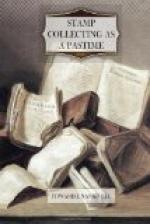[Illustration:]
Ceylon, 1859, 4d. and 8d., imperforate.—Several of the first issues of this colony, designed and engraved by Messrs. Perkins Bacon and Co., and issued in 1857-9, are esteemed as great rarities in an imperforate and unused condition. The 4d., 8d., 9d., 1s., and 2s. are the rarest. The 4d., so long ago as 1894, fetched L130 at auction. These stamps are amongst the few great rarities that may be entitled to rank as works of art, and every year they are more sought after and more difficult to get in fine condition.
[Illustration:]
[Illustration:]
IX.
The Romance of Stamp Collecting.
The story of the development of stamp collecting, and of the trade that has sprung up with it, is full of romance.
Our publishers’ business, with its world-wide ramifications, was begun by young Gibbons putting a few sheets of stamps in his father’s shop window. The father was a chemist, and it was intended that the lad should follow in his father’s footsteps; but the stamps elbowed the drugs aside, and eventually yielded a fortune which enabled this pioneer of the stamp trade to retire and indulge his globe-trotting propensities to the full. He sold his business for L25,000, and, still in the prime of life, retired to a snug little villa on the banks of the Thames. The business was converted into a Limited Liability Company, and the Managing Director may be said to be a product of the original business, for it was a present of a guinea packet of Stanley Gibbons’s stamps that first whetted his appetite for stamp collecting, and eventually for stamp dealing. Mr. Gibbons had for a great many years conducted his business from his private house. The new broom changed all that, and opened out in fine premises in the Strand, W.C., where the Company now occupy the whole of one house and the greater part of the adjoining premises. In every room busy hands are at work all the day long endeavouring to keep pace with a world-wide business which began with a few sheets in the corner of a chemist’s shop window in the town of Plymouth.
And now, looking back on the humdrum days of the beginnings of the stamp trade, what opportunities do they not seem to have missed! Could they but have foreseen the present-day developments, a few unconsidered trifles, valued at a few pence in those days, put away in a bottom drawer, would to-day net a fortune. Young Gibbons, amongst his early purchases, bought from a couple of sailors at Plymouth for L5 a sackful of triangular Cape of Good Hope stamps, a large proportion being the rare so-called Woodblocks, with many of the Errors described in the list of great rarities in another chapter. Those Errors he disposed of at 2s. 6d. each. They are now worth from L60 to L75 each. And the ordinary Woodblocks, which were so plentifully represented in that sackful, are now catalogued at from 50s. to L9 apiece. Strange as it may seem, those were the common stamps of those days, and they are the rarities of to-day.




